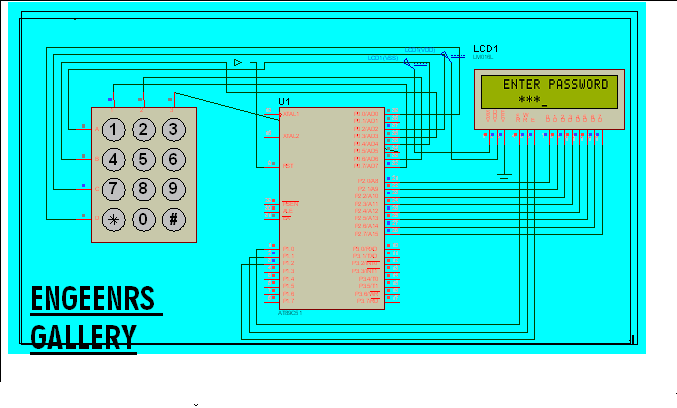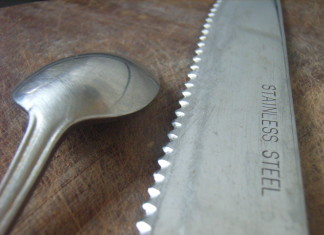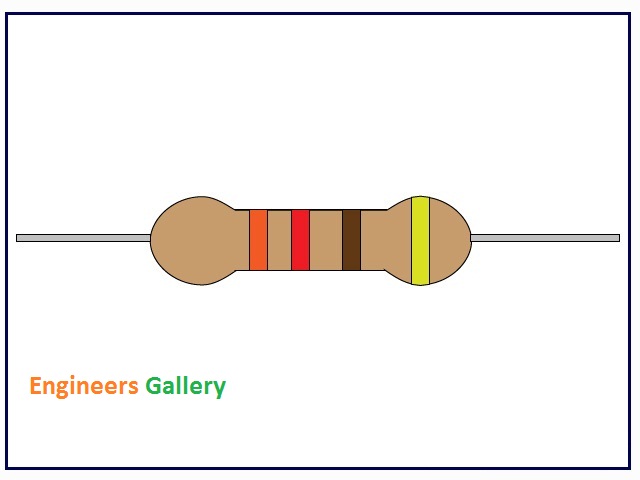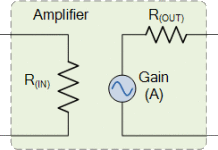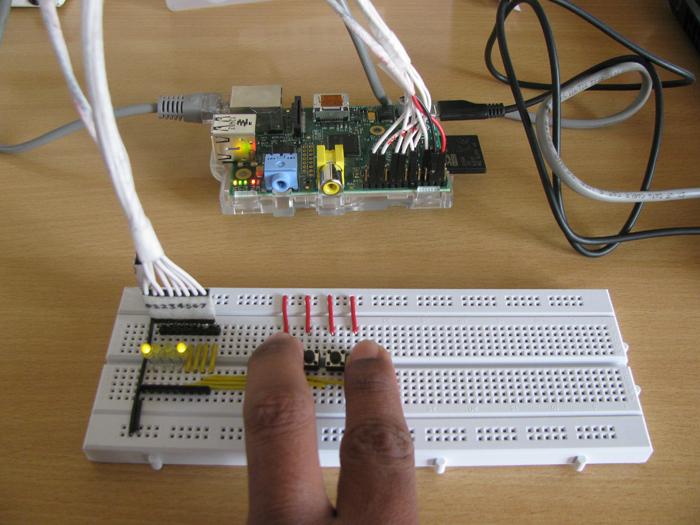Electronic code lock with user defined password using 8051 microcontroller (AT89C51)
[nextpage title=”Summary” ]
SUMMARY:
An electronic lock or digital lock is a one type of 8051 microcontroller applications which has an electronic control assembly attached to it. They are provided with an access control system. This system allows the user to unlock the device with a password. The password is entered by making use of a keypad. The user can also set his password to ensure better protection. The major components include a keypad, LCD and the controller AT89C51 which belongs to the 8051 series of microcontrollers. This article describes the making of an electronic code lock using the 8051 mcu.
[/nextpage]
[nextpage title=”Description” ]
DESCRIPTION:
A 4×3 matrix keypad and a 16×2 LCD have been used here. Keypad and LCD are very commonly used input & output devices, respectively. A four digit predefined password needs to be specified the user. This password is stored in the system.
While unlocking, if the entered password from keypad matches with the stored password, then the lock opens and a message is displayed on LCD. Also an output pin is made high to be used for further purpose.
The connections in the circuit are as following: port P2 of microcontroller AT89C51 is used as data input port which is connected to data pins (7-14) of LCD. P1^0, P1^1 and P1^2 pins of microcontroller are connected to control pins RS, RW and EN of LCD. Port P0 is used to take input from keypad. P0^7 has been used as lock output pin of controller. It uses ic 8051.
As the program starts, string ‘Enter Password’ is displayed on LCD. The keypad is scanned for pressed digits one by one. Every time, row and column of the key pressed is detected and a ‘*’ is displayed on LCD corresponding to the entered number. After the four digits are entered, the user is prompted to ‘Confirm Password’ and again the input is taken through LCD. If the passwords do not match, a message is displayed to indicate ‘Wrong Password’; otherwise the user is prompted to unlock the device.
[/nextpage]
[nextpage title=”Circuit Diagram” ]

[/nextpage]
[nextpage title=”Code” ]
//Program to make a code lock with user defined password
[visitor]
⇒ Subscribe to view Code (Free Registration )
[/visitor]
[member]
[message_box title=”CODE” color=”yellow”]
#include<reg51.h>
#define port P1
#define dataport P2
#define key P0
#define sec 100
sbit rs = port^0;
sbit rw = port^1;
sbit en = port^2;
sbit col1=key^4;
sbit col2=key^5;
sbit col3=key^6;
sbit row1=key^0;
sbit row2=key^1;
sbit row3=key^2;
sbit row4=key^3;
sbit lock_output=P0^7;
int check=0;
int digit[4]={0,0,0,0};
int dig_input[4]={0,0,0,0};
int dig_input_recheck[4]={0,0,0,0};
int i,k;
void delay(unsigned int msec) // Time delay function
{
int i,j ;
for(i=0;i<msec;i++)
for(j=0;j<1275;j++);
}
void lcd_cmd(unsigned char item) // Function to send command to LCD
{
dataport = item;
rs= 0;
rw=0;
en=1;
delay(1);
en=0;
return;
}
void lcd_data(unsigned char item) // Function to send data to LCD
{
dataport = item;
rs= 1;
rw=0;
en=1;
delay(1);
en=0;
return;
}
void lcd_data_string(unsigned char *str) // Function to send data to string
{
int i=0;
while(str[i]!=”)
{
lcd_data(str[i]);
i++;
//delay(10);
}
return;
}
void lcd(unsigned char str[10])
{
lcd_cmd(0x38);
lcd_cmd(0x0e);
lcd_data_string(str);
}
void ans()
{
if(check>3)
{
lcd_cmd(0x01);
lcd_cmd(0x82);
lcd_data_string(” LOCK OPEN”);
lock_output=1;
delay(300);
}
else
{
lcd_cmd(0x01);
lcd_cmd(0x82);
lcd_data_string(” WRONG PASSWORD”);
lock_output=0;
delay(300);
}
}
void code_check() // Function to check password
{
if(i<=3 )
{
switch((i+1))
{
case 1: {
if(dig_input[0]==digit[0])
{
check=check+1;
}
break;
}
case 2: {
if(dig_input[1]==digit[1])
{
check=check+1;
}
break;
}
case 3: {
if(dig_input[2]==digit[2])
{
check=check+1;
}
break;
}
case 4: {
if(dig_input[3]==digit[3])
{
check=check+1;
}
break;
}
}
}
delay(10);
if(i==3)
{
ans();
}
}
void display(int a) //Display function
{
switch(a)
{
case 1:{
lcd_data(‘*’);
delay(100);
digit[i]=1;
code_check();
break;
}
case 2:{
lcd_data(‘*’);
delay(100);
digit[i]=2;
code_check();
break;
}
case 3:{
lcd_data(‘*’);
delay(100);
digit[i]=3;
code_check();
break;
}
case 4:{
lcd_data(‘*’);
delay(100);
digit[i]=4;
code_check();
break;
}
case 5:{
lcd_data(‘*’);
delay(100);
digit[i]=5;
code_check();
break;
}
case 6:{
lcd_data(‘*’);
delay(100);
digit[i]=6;
code_check();
break;
}
case 7:{
lcd_data(‘*’);
delay(100);
digit[i]=7;
code_check();
break;
}
case 8:{
lcd_data(‘*’);
delay(100);
digit[i]=8;
code_check();
break;
}
case 9:{
lcd_data(‘*’);
delay(100);
digit[i]=9;
code_check();
break;
}
case 0:{
lcd_data(‘*’);
delay(100);
digit[i]=0;
code_check();
break;
}
}
}
void check_col1()
{
row1=row2=row3=row4=1;
row1=0;
if(col1==0)
display(1);
row1=1;
row2=0;
if(col1==0)
display(4);
row2=1;
row3=0;
if(col1==0)
display(7);
row3=1;
row4=0;
if(col1==0)
{
row4=1;
}
}
void check_col2()
{
row1=row2=row3=row4=1;
row1=0;
if(col2==0)
display(2);
row1=1;
row2=0;
if(col2==0)
display(5);
row2=1;
row3=0;
if(col2==0)
display(8);
row3=1;
row4=0;
if(col2==0)
display(0);
row4=1;
}
void check_col3()
{
row1=row2=row3=row4=1;
row1=0;
if(col3==0)
display(3);
row1=1;
row2=0;
if(col3==0)
display(6);
row2=1;
row3=0;
if(col3==0)
display(9);
row3=1;
row4=0;
if(col3==0)
{
row4=1;
}
}
void check_password_col1()
{
row1=row2=row3=row4=1;
row1=0;
if(col1==0)
dig_input[k]=1;
row1=1;
row2=0;
if(col1==0)
dig_input[k]=4;
row2=1;
row3=0;
if(col1==0)
dig_input[k]=7;
row3=1;
row4=0;
if(col1==0)
{
row4=1;
}
}
void check_password_col2()
{
row1=row2=row3=row4=1;
row1=0;
if(col2==0)
dig_input[k]=2;
row1=1;
row2=0;
if(col2==0)
dig_input[k]=5;
row2=1;
row3=0;
if(col2==0)
dig_input[k]=8;
row3=1;
row4=0;
if(col2==0)
{
dig_input[k]=0;
row4=1;
}
}
void check_password_col3()
{
row1=row2=row3=row4=1;
row1=0;
if(col3==0)
dig_input[k]=3;
row1=1;
row2=0;
if(col3==0)
dig_input[k]=6;
row2=1;
row3=0;
if(col3==0)
dig_input[k]=9;
row3=1;
row4=0;
if(col3==0)
{
row4=1;
}
}
void pass_set()
{
row1=row2=row3=row4=0;
while(col1==1 && col2==1 && col3==1);
for(i=0;i<4;i++)
{
k=i;
delay(50);
lcd_cmd(0xc4+i);
delay(100);
row1=row2=row3=row4=0;
while(col1==1 && col2==1 && col3==1);
row1=row2=row3=row4=0;
if(col1==0)
check_password_col1();
else
if(col2==0)
check_password_col2();
else
if(col3==0)
check_password_col3();
lcd_data(‘*’);
delay(50);
}
}
void main()
{
int e,j=0,count=1;
col1=col2=col3=1;
//FOR PASSWoRD INPUT
do
{
lcd_cmd(0x01); //Clear LCD screen
lcd_cmd(0x81);
lcd(“ENTER PASSWORD:”);
pass_set();
for(e=0;e<4;e++)
dig_input_recheck[e]=dig_input[e];
lcd_cmd(0x01);
lcd(“CONFIRM PASSWORD:”);
pass_set();
for(e=0;e<4;e++)
{
if(dig_input_recheck[e]==dig_input[e])
j++;
}
if(j<4)
{
lcd_cmd(0x01);
lcd_cmd(0x85);
lcd(“PASSWORD”);
lcd_cmd(0xC2);
lcd(“NOT MATCH”);
delay(300);
}
}
while(j<4);
while(count<4) //Code input and check
{
lcd_cmd(0x01);
lock_output=0;
lcd_cmd(0x82);
lcd(“ENTER PASSWORD”);
check=0;
row1=row2=row3=row4=0;
while(col1==1 && col2==1 && col3==1);
for(i=0;i<4;i++)
{
delay(100);
lcd_cmd(0xc4+i);
row1=row2=row3=row4=0;
while(col1==1 && col2==1 && col3==1);
row1=row2=row3=row4=0;
if(col1==0)
check_col1();
else
if(col2==0)
check_col2();
else
if(col3==0)
check_col3();
}
count++;
delay(1);
}
if(count==4)
{
lcd_cmd(0x01);
lcd_cmd(0x86);
lcd(“SORRY”);
lcd_cmd(0xc1);
lcd(“NO MORE TRIALS”);
while(1);
}
}
[/message_box]
[/member]
[/nextpage]
Here it use 8051 rtos, and you can search for 8051 pin diagram here. You can serch in engineersgallery to for 8051 compiler.

